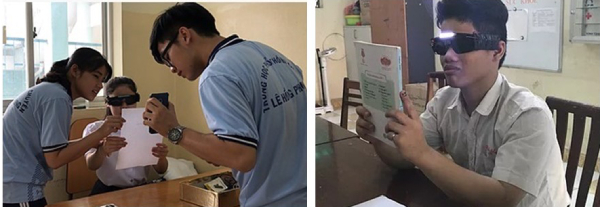
The glasses can recognize Vietnamese language and read content aloud for users with a high accuracy rate of up to 89 percent.
 |
The glasses can recognize Vietnamese language and read content aloud for users with a high accuracy rate of up to 89 percent.
The product was created by Nguyen Hoang Minh Khoi, an information technology major at RMIT Vietnam University.
Khoi thought of the idea when he was a student at Le Hong Phong High School for the Gifted in HCM City. He wanted to make something to help the blind read newspapers and books.
At that time, he worked as a volunteer at the Nguyen Dinh Chieu Specialized School for visually impaired students. He decided to create a sustainable solution to support their study.
“Businesses and organizations often forget the needs of people with disabilities," Khoi said. “Learning materials and tools are often designed for the general public. I want to break through this barrier and give people with disabilities an equal learning experience."
The glasses have a light sensor system, a camera that captures images of text documents to transfer to the phone for analysis with the Google Vision system and Tesseract (technology that helps identify characters on a photo). After the analysis, the system will play audio through the speaker. Khoi's glasses can read text to audio with an accuracy of up to 89 percent.
After a period of research and testing which showed good results, Khoi shared the formulas and instructed technicians from many organizations on how to assemble smart glasses. With financial support from sponsors, 50 pairs of smart glasses were assembled and donated to the students who needed them.
In addition to helping the students during their studies, Khoi also enjoys spreading his love of science, technology, engineering and math (STEM) to children with the desire to contribute to the development of the country’s science and technology.
Khoi founded a community project called "InspireX" in 2018 to inspire students to learn STEM through interesting activities. Within a year, InspireX partnered with experts to organize five sessions to help students gain hands-on experience and change their thoughts about STEM.
The scale of the class has been expanding, from 30 to 150 learners for each session. However, as Khoi admitted, the figure was small compared with the number of students in society.
“I hope Inspire X can expand and bring STEM to rural areas so as to contribute to the development of the country’s science and technology,” Khoi said.
Khoi recommends that your peers step out of their comfort zone and experience as much as possible because they still have plenty of time to experiment and explore. Each person needs to try and fail many times to discover what they want.
(Source: VNN)





